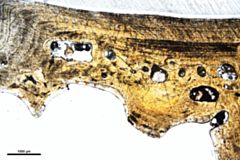Project 3775: C. T. Heck, G. Volkmann, H. N. Woodward. 2020. Polyester or epoxy: assessing embedding product efficacy in paleohistological methods. PeerJ. 8:e10495.
Abstract
Histological examination of bone microstructure provides insight into extant and extinct vertebrate physiology. Fossil specimens sampled for histological examination are first embedded in a plastic resin which is then cut into thin sections, mounted on slides, and polished for viewing. Modern undecalcified bone is chemically processed prior to embedding in plastic resin, sectioning, mounting, and polishing. Embedding procedure for fossil material often utilizes inexpensive polyester resin. Conversely, small fossil material and modern undecalcified bone is typically embedded in higher priced epoxy resin because these specimen types require thin sections near or below 100µm thick. Anecdotal evidence suggests thin sections made of polyester resin embedded material thinner than 100µm increases likelihood of sample peeling, material loss, and is unsuitable for modern tissue and small fossil material embedding. To test this assumption, a sample of modern bones and fossil bones, teeth, and scales were embedded in either polyester resin or epoxy resin. Embedded specimens were sectioned and mounted following standard published protocol. Thin sections were ground on a lapidary wheel using decreasing grit sizes until tissue microstructure was completely discernible when viewed under a polarizing light microscope. Additionally, eight prepared thin sections (four from polyester resin embedded specimens and four from epoxy resin embedded specimens) were continuously ground on a lapidary wheel using 600 grit carbide paper until peeling or material integrity was lost. Slide thickness when peeling occurred was measured for comparing slide thickness when specimen integrity was lost between the two resin types. Final slide thickness ranged from 30µm to 250µm when tissue was identifiable under a polarized microscope. Finished slide thickness varied between resin types despite similar tissue visibility. However, finished slide thickness appears more dependent on hard tissue variation than resin type. Additionally, we did not find a difference of slide thickness when material was lost between resin types. The results of this preliminary study suggest that polyester resins can be used for embedding undecalcified modern hard tissues and fossilized hard tissues without loss of tissue visibility or material integrity.Read the article »
Article DOI: 10.7717/peerj.10495
Project DOI: 10.7934/P3775, http://dx.doi.org/10.7934/P3775
| This project contains |
|---|
Download Project SDD File |
Currently Viewing:
MorphoBank Project 3775
MorphoBank Project 3775
- Creation Date:
21 July 2020 - Publication Date:
18 November 2020
Authors' Institutions ![]()
- Oklahoma State University

